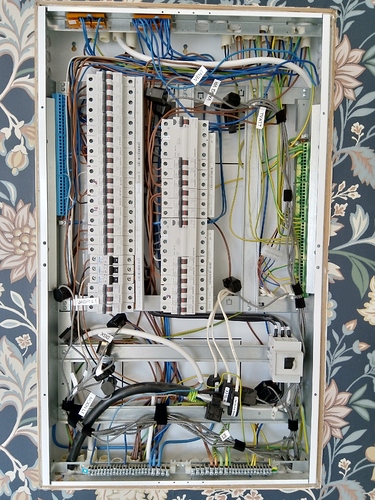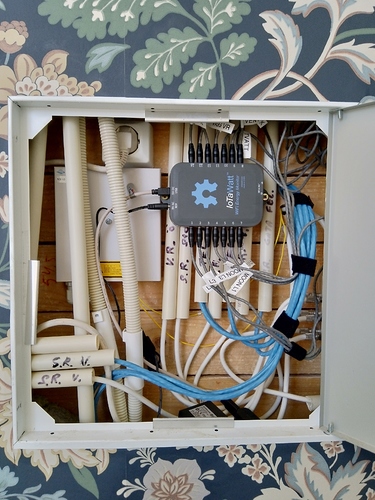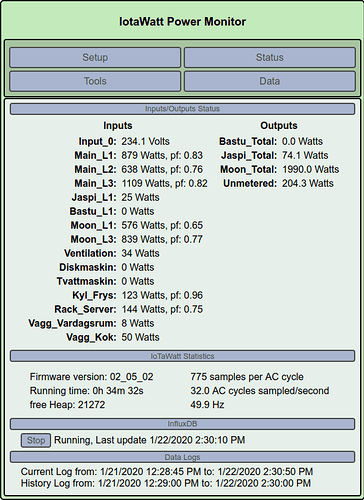Preface
I finally got my IotaWatt a couple of days ago and thought I share my experience setting it up. I did a lot of research before buying it to minimize any unexpected issues, but even so, I ran into a few roadblocks along the way.
A recurring “problem” is that the documentation as well as various anecdotes on the Internet focus solely on the US split-phase power delivery system, which is drastically different from the three-phase system used in Finland. I figured I’d explain the basics of how power delivery works over here before documenting the actual installation.
Power is delivered through a 5-wire system (three phases, one neutral, one protective earth). Apparently these are called 4-wire systems, I’m not sure why. After the main breaker, the three phases are divided evenly among two row of circuit breakers.
Most circuits/appliances use only one phase, but a couple use all three phases; the stove, the “heating central”, the heat pump and the sauna.
Initial setup (mains)
I started by powering up the IotaWatt in order to connect it to my wifi network. I only have 5 GHz, so the IotaWatt couldn’t find it. I solved this by making a separate hidden 2.4 GHz for the IotaWatt.
Next was connecting CTs for the three mains phases (called L1, L2 and L3 over here). I checked “derived three-phase” and configured L1 = A, L2 = B and L3 = C. No problems here, except the IotaWatt had detected all the CTs as being reversed, even though I was sure I had them the right way. Turns out the VT must be plugged in the “right” way. This is sadly not documented at all, but the solution is to either plug it in the opposite way, or check Reversed in the VT configuration.
Initial setup (individual circuits)
I proceeded to connect CTs to the various single-phase circuits I wanted to monitor. This is pretty simple so no issues there.
Initial setup (three-phase circuits)
Measuring the power for the sauna/heat pump etc. yielded some issues. I naively thought that I could just run all three phases through one CT and thus measure the total power, but it doesn’t actually work in practice. The documentation makes it sound like this can be done, but apparently it only works in America where the two phases are aligned (I may be wrong here, I’m no electrician). If you run all three phases through one CT, you will get a power measurement close to 0 watts.
Next up I connected CTs to each individual phase for the sauna, heat pump and heating central. I determined that the sauna has very even phase distribution (my model uses 3x3 kW for a total of 9 kW), the heating central is very similar (it uses 3x1.5 kW to heat the tap water), and the heat pump used around 200 watts more on L3 than the other two phases.
Armed with this knowledge, I decided to measure just L1 for the sauna, L1 for the heating central and L1 + L3 for the heat pump. The total usage can then be deduced as “outputs” in the IotaWatt.
Final setup
Here’s a photo of the panel:
The thick black wire is the mains. The three CTs that have white wires are not related to the IotaWatt (they go to the heating central so it can regulate itself). On the left column near the bottom you can see groups of three circuit breakers which are for three-phase appliances.
Here’s a photo of the smaller panel where the IotaWatt is housed (it’s below the breaker panel):
The wall outlet is on L1, which makes it easier to reason about it since IotaWatt always assigns the phase the VT is on as “phase A”. This is why L1 = A, L2 = B etc. works in my case.
Here’s the inputs and outputs from the IotaWatt status page:
Bastu_Total is “Bastu_L1 * 3”, Jaspi_Total is “Jaspi_L1 * 3”, Moon_Total is “Moon_L1 * 2 + Moon_L3”.
Issue summary
The documentation could mention the following things:
- The fact that the IotaWatt only has 2.4 GHz wifi
- That the VT has to have the right polarity, otherwise all CTs are detected as reversed
- That you can’t measure three-phase by running all three phase wires through a single CT
Feature suggestions
These minor things would not hurt:
- It would be nice to be able to double or triple the readings from a single CT instead of having to create a separate output
- The web interface could send CORS header so developing alternative web interfaces could be done without having to upload the files to the IotaWatt and use the built-in web server
Store nitpicks
The main breaker is rated for 3x25 amps, which means I really don’t need the big 100A CTs. Unfortunately it doesn’t seem to be possible to order 14 50A CTs as part of the bundles, the store caps the maximum to 11. Even the 50A CTs are way too big for what we need over here (most phase wires are either 1.5mm2 or 2.5mm2).


